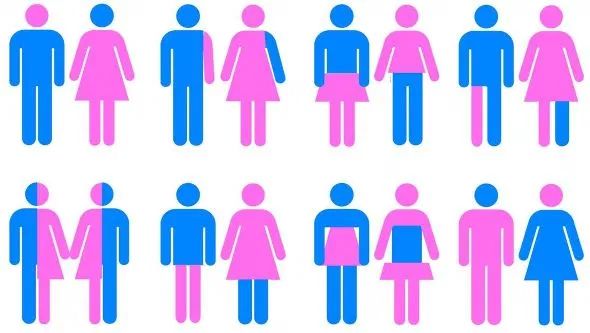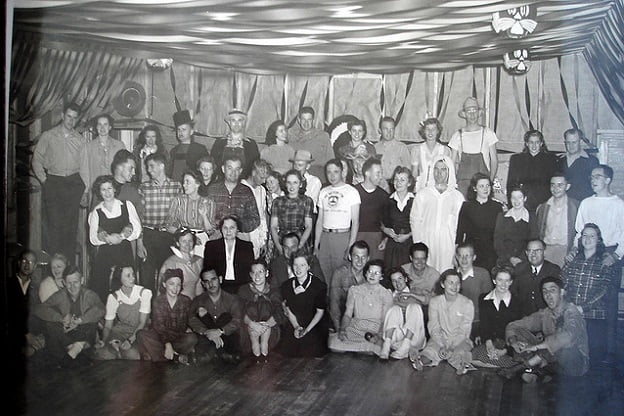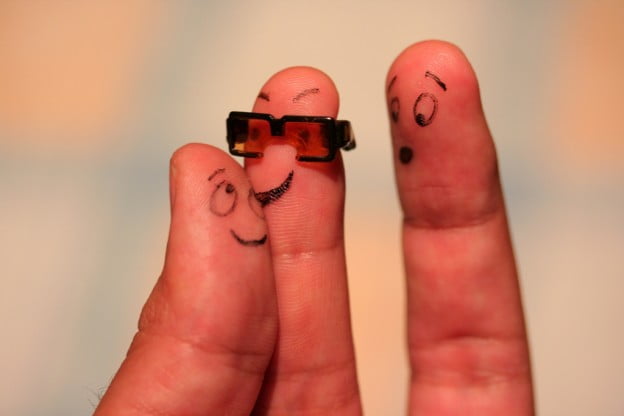Sexual Health
Gender & Sexual Orientation
Gender vs. Sex
People often use the terms gender and sex interchangeably when talking about a person being male or female. However, the terms are very different and apply to different aspects of a person’s identity.
Sex refers to the biological differences between people (chromosomes, hormonal profiles, or internal and external sex organs).
Gender refers to cultural values that are either masculine or feminine, some combination of both, neither, or something else.
Gender identity refers to how one thinks of one’s own gender: whether one thinks of oneself as a man (masculine) or as a woman (feminine.) The way society expects a feminine or masculine person to act (dress, speak, relate to others) is called a gender role or social gender role and forms our construct or definition of what gender is.
Gender expression is how people might communicate their sex/gender to others: clothing, hair styles, mannerisms, way of speaking, roles we take in interactions, etc.
Sexual Orientation
Sexual orientation is defined as “an enduring emotional, romantic, sexual, or affectional attraction toward others. It is easily distinguished from other components of sexuality including biological sex, gender identity (the psychological sense of being male or female), and the social gender role (adherence to cultural norms for feminine and masculine behavior).”
Traditional sexual orientation has been divided into three categories: homosexual, bisexual and heterosexual. Although not all people identify with one of these categories, preferring other more inclusive terms such as poly-sexual, or preferring not to identify.
- Homosexuality refers to individuals who are attracted to people of the same gender. The term “gay” can refer to men or women who are attracted to the same sex but generally refers to men, whereas lesbian only refers to women attracted to other women.
- Bisexuality refers to individuals who are attracted to both genders. Some people find the term bi confining, as it implies being only attracted to two genders, excluding some members of the trans community. Terms like polysexual (attracted to many genders) and pansexual (attracted to all genders, or gender blind) may be used instead.
- Heterosexuality refers to individuals who are attracted to the opposite sex (men attracted to women and vice versa), and is sometimes called “straight.”
Sexual orientation is a widely debated topic and there are numerous theories about the origins of a person’s sexual orientation. Most scientists today agree that sexual orientation is most likely the result of a complex interaction of environmental, cognitive and biological factors. Most people know of their sexual orientation at an early age (“I remember liking boys/girls since I was 3 or 4?).
Sexual orientation should be distinguished from sexual behavior. Sexual behavior are the sexual acts people engage in alone or with others and may not correlate or match-up with a person’s sexual orientation. For example, a man may have some sexual experiences with other men as well as women but he may only identify as a straight male.
Sexual behavior is often described along a continuum. Kinsey developed a 7-point scale of heterosexuality and homosexuality. People could rank from “exclusively heterosexual” to “exclusively homosexual” to anywhere in between. And a person’s rating could change over time as experiences accumulated.
For example, a person might have all heterosexual experiences for the first twenty years of life and then have ten years of homosexual experience. By the same token, a person might have all homosexual encounters for twenty years and then have heterosexual activity. (You can learn more about the scale
Queer/Questioning/GLBTT2IQA
Once a derogatory term against people perceived to be GLBT, queer is beginning to be embraced by some members of the GLBT community as an umbrella identity term encompassing gay, lesbian, questioning, bisexual, non-labelling, transgender people, and anyone else who does not strictly identify as heterosexual.
Queer is also used in a political context and in academic settings to challenge traditional ideas about identity (“queer theory”). Questioning refers to people who are uncertain as to their sexual orientation or gender identity. They are often seeking information and support during this stage of their identity development.
GLBTT2IQA – This abbreviation stands for “Gay, Lesbian, Bisexual, Transgendered, Transsexual, 2-spirited, Intersexed, Queer/Questioning and Allies.” Sometimes people use more or fewer letters or a different combination, but the intent is usually to use an inclusive term for anyone with a non-mainstream sexual orientation or gender identity. You will most often hear GLBTQ or just GLBT/LGBT when people refer to the community around sexual orientation.
Gay, Lesbian, Bisexual (GLB) FAQ
What is homosexuality?
Homosexuality is a sexual and/or romantic orientation characterized by attraction to people of your own sex. Being gay or lesbian is a normal, healthy state of being. It is not a disease, it is not a mental disorder, it is not neurotic, and it is not dangerous.
Stereotypes – Many people think that all gay men are very feminine, while all lesbian women are very masculine. But homosexual people are as varied as any other people. It is impossible to know a person’s sexual preference simply by looking at him or her.
How many people are gay?
Alfred Kinsey established the figure of 10% of men and slightly fewer of women are homosexual. Since his work (first published in 1947), a lot of studies have found figures ranging from 2%-15%.
The differences in numbers can be mainly accounted for by the difference in definition of “homosexual.” The famous 10% figure includes men who had predominantly homosexual contact for at least three years.
Other figures require exclusively homosexual contact, while others allow a wider range of sexual behavior and desires. Another key thing is that it doesn’t really matter how many people are gay. Homosexual people are just like anyone else, just like lefthanded people – another invisible minority, and roughly the same percentage of people.
The only difference is that homosexual people are attracted to people of their own sex.
What’s the difference between homosexuality and bisexuality?
Bisexuality is a sexual and romantic orientation characterized by attraction to people regardless of sex. Many people who self-identify as homosexual have had heterosexual relationships, but they express a distinct preference for relationships with people of their own sex, just as heterosexual people express a distinct preference for relationships with people of the opposite sex.
Alfred Kinsey’s interview data supported the idea that about 8% of the American population are bisexual. Some people believe that people who identify as bisexual are in denial about being gay or lesbian.
While it is true that some people who eventually identify as gay or lesbian went through a period of identifying as bisexual, it is also true that some people are attracted to both men and women and identify as bisexual (and never as gay or lesbian).
How to Be an Effective Ally
What is alliance?
Alliance is a proactive act of self-love. When you assert your alliance, you prove that it doesn’t matter what differences lie between you and anyone else, you respect all human creatures as equals.
LGBT people are our mothers, fathers, sons, daughters, sisters, brothers, aunts, uncles and cousins. This is a fact and it isn’t going away. You have the opportunity to be an ally and a friend at home, school, church and work. A straight ally can merely be someone who is supportive and accepts the LGBT person, or a straight ally can be someone who personally advocates for equal rights and fair treatment.
Allies are some of the most effective and powerful voices of the LGBT movement. Not only do allies help people in the coming-out process, they also help others understand the importance of equality, fairness, acceptance and mutual respect.
What Can You Do?
The Gay & Lesbian Alliance Against Defamation (GLAAD) has a helpful list of ten things you can do to be a GLBT ally:
- Be a listener.
- Be open-minded.
- Be willing to talk.
- Be inclusive and invite LGBT friends to hang out with your friends and family.
- Don’t assume that all your friends and co-workers are straight (or gay). Someone close to you could be looking for support in their coming-out process. Not making assumptions will give them the space they need.
- Homophobic comments and jokes are harmful. Let your friends, family and co-workers know that you find them offensive.
- Confront your own prejudices and homophobia, even if it is uncomfortable to do so.
- Defend your LGBT friends against discrimination.
- Believe that all people, regardless of gender identity and sexual orientation, should be treated with dignity and respect.
- If you see LGBT people being misrepresented in the media, contact glaad.org.
Transgender Topics
Frequently Asked Questions – Transgender
Q: What does the term “transgender” mean?
A: The term transgender originally referred to individuals who had chosen to live as the opposite gender without the aid of surgery or hormones. Currently, transgender is used as an umbrella term which includes all people who have gender identities, expressions, or behaviors not traditionally associated with their birth sex. This may (but does not necessarily) include male-to-female and female-to-male transsexuals, male and female crossdressers, drag kings and queens, and others with nontraditional gender expressions.
Q: How should I refer to a transgender person?
A: You should make sure to refer to a transperson by their preferred gender. People can choose the pronouns that they identify with, and not all transpeople necessarily use the gender pronouns you may assume (she/he). There is a wide range of gender, and non gendered pronouns. Some gender neutral pronouns include per (per is looking great today, that is per’s hous), xe (xe laughed, I called xem), and alternating between male and female pronouns, but there are many others. Also, many transpeople may change their pronouns at different steps in their life. If you are not sure which set of pronouns is appropriate, there are polite ways to ask. In general, asking nicely is the best way to learn something about a transperson you have just encountered.
Q: How does transgender differ from transsexuals, transvestites, crossdressers, or drag performers?
A: A transsexual is someone whose gender identity does not match their physical body and who uses hormones or various surgeries to change their external gendered appearance. The word transvestite refers to an individual, usually a biological male, who dresses in the opposite gender’s clothing for sexual or emotional pleasure. These people are usually heterosexual, do not wear the opposite gender’s clothing all the time, and usually do not view themselves as members of the opposite gender. Another word for transvestite is crossdresser, a word which many who crossdress prefer to the term transvestite (which has negative medical connotations). Drag performers are individuals who perform in clothing associated with men or women and who emphasize gender stereotypes for entertainment or political purposes. The term transgender is a broader term, which includes individuals such as transsexuals and crossdressers, as well as other gender variant individuals.
Q: Are transgender people gay?
A: Sexual orientation (how one defines his sexual attractions) is separate from gender identity (how one defines his internal sense of gender). Some transpeople identify as heterosexual, some as homosexual or bisexual, and some refuse to use conventional sexual orientation labels to describe to whom they are attracted. Most crossdressers, however, are heterosexual. Tapestry Magazine did a survey on the sexual orientation of its crossdressing readers and found that 75 percent of them are heterosexual.
Q: Are transgender people usually males who feel they are women?
A: There are both male-to-female – whom many refer to as m-to-f or MtF – and female-to-male (f-to-m or FtM) transgender individuals. If one uses statistics from surgery, he might assume that more MtFs exist, however, this may seem to be for reasons other than a vastly larger number of MtFs. First, if one judges the number of MtFs and FtMs solely on the number of bottom surgery cases, it would appear that a greater number of MtFs exist because a greater number of MtFs choose to undergo bottom surgery, not because more MtFs exist in the population at large. Next, the issue of visibility affects the number of perceived MtF and FtM transpeople. Because MtFs are shown more often on television and movies, as well as the fact that they often do not pass as well as many FtMs, the public erroneously assumes the rate of MtFs is far larger than that of FtMs. Today, estimates assume that the numbers of female-bodied and male-bodied transpeople is roughly equal.
Q: Is being transgender the same as being intersexed or a hermaphrodite?
A: No. Intersex individuals are born with ambiguous sex organs. Transpeople are usually born with clearly male or female sex organs, but feel their gender identity is at odds with their physical sex. It is possible for intersex individuals to identify as transgender, but very few transpeople were born intersex.
Q: How prevalent is the phenomenon of transgenderism?
A: The prevalence of transgenderism varies depending on the definition one uses. If one uses statistics from surgery or hormones, this would leave out a large segment of the transgender population who chooses not to alter their bodies. If one uses a broader definition of anyone who transgresses traditional gender norms, the number of transpeople will be drastically larger.
Q: Is being transgender a lifestyle “choice,” or is there a biological reason people are transgender?
A: What little research is available has not given adequate information about what causes an individual to identify as transgender. Some research suggests a part of the brain affected by in utero hormone levels is responsible for an individual’s core sense of gender identity. Others claim that it is merely the rigid two-gender system which creates the need for transgender identification; these people claim that if gender roles were more fluid, individuals would not need to seek out bodily changes. No matter what the reason, individuals with variant gender expressions and identities do exist in every society and deserve the same respect and individual rights as other human beings.
Q: How does a transgender individual go about beginning to take hormones?
A: According to the WPATH Standards of Care, individuals must usually undergo a period of therapy before receiving a letter of recommendation from a psychiatrist to begin hormones. Most transwomen take both estrogen (topically or orally) and sometimes a testosterone blocker (orally), while transmen usually only take testosterone (intramuscularly or topically). These hormones produce permanent and semi-permanent changes in external secondary sex characteristics, including, but not limited to, redistribution of body fat, change in skin texture, breast growth (for transwomen), increased body hair and muscle mass (for transmen).
Q: Do transpeople usually take hormones before undergoing surgery?
A: Many do first take hormones and then undergo surgery. Others first have surgery and then choose to take hormones. Still others choose to only undergo surgery, only take hormones, or to do neither. There are as many combinations of transition steps as there are different kinds of transpeople.
Q: What is involved with undertaking sex reassignment surgery?
A: Again, according to the WPATH Standards of Care, individuals must usually undergo an extensive period of therapy (from months to years) before receiving a letter from a psychiatrist which describes them as an informed surgery candidate. Almost all surgeons require such a letter before performing any type of trans-related surgery. Most transgender surgery is not covered by health insurance, and the costs of such surgery are often so exorbitant that it prevents many transpeople from acquiring the procedures they desire. Details of transgender procedures can be found at various sources online.
Q: What is a pre/post/non-op transsexual?
A: Pre, post, and non-op refer to stages of a transperson’s transition. Pre-op refers to someone who has yet to have gender reassignment surgery but plans on doing so. Post-op refers to someone who has already had surgery. Non-op refers to someone who has elected not to have surgery. Not all transpeople use these terms to describe themselves, and these are words which should only be used by transpeople to describe their own sense of where they are in terms of their transition.
Q: Do transgender people face discrimination?
A: Yes. Gender identity and expression are only included in the anti-discrimination laws of a few states and cities around the country. This means that in a vast majority of states, transpeople can be discriminated against in housing, employment, education, and other areas of life. Transpeople who do not pass as well are subject to more discrimination than those who live undetected. Also, transpeople who appear to be masculine women or feminine men, or who are dating someone of the same gender, are subject to the same homophobia that gay, lesbian, and bisexual individuals are. On average, more than one transgender individual is murdered every month. Transpeople must worry not only about whether or not their family and friends will be supportive, but also whether they will lose their jobs, be denied housing, be refused medical care, or be harassed, beaten, or murdered. For all gender-variant individuals, discrimination is a very real and ever-present part of daily life.
Q: What do I do if I encounter a transgender person?
A: First, treat transpeople as you would treat any other individual, with courtesy and respect. Respect their gender identification, and pronouns. Second, If you would like to understand an individual transperson’s needs and struggles, offer to actively listen and ask respectful, constructive questions.
Glossary of Transgender Related Terms
MtF (or M-to-F, M2F): A male-to-female transperson. One born biologically male who identifies as a woman or as transgender.
FtM (or F-to-M, F2M): A female-to-male transperson. One born biologically female who identifies as a man or as transgender.
Bottom Surgery: Refers to genital construction surgery for either male-to-female or female-to-male transpeople.
DSM-IV: The DSM-IV is “The Diagnostic and Statistical Manual of Mental Disorders”. It is the publication put out by the American Psychiatric Association which details what is and is not a psychiatric illness. Transsexualism and transvestitism are still included in the list of psychiatric disorders.
Cisgender: Someone who is comfortable with the gender they were assigned at birth, someone who is not transgender.
Genderqueer: An individual who feels their gender identity exists outside the gender binary; these individuals refuse to identify as either/or. The term “genderqueer” is relatively new and has only gained some popularity within the last few years. As with all identity labels, the term genderqueer should only be used by individuals to describe themselves, and the definition each individual gives to the word will vary depending on their life experience.
Harry Benjamin Standards of Care: The Harry Benjamin Standards of Care were created at a conference by Dr. Harry Benjamin and were published by the Harry Benjamin International Gender Dysphoria Association. When the Association was renamed to the World Professional Association for Transgender Health (WPATH), the standards were renamed the WPATH Standards of Care.
Passing: The ability to interact with others and be accepted as one’s preferred gender. Example: A transwoman may say: “I thought I was passing in the grocery store until the cashier called me ‘sir’.”
RLT (Real Life Test): RLT means that a transperson is living as their preferred gender for a period of time before having any type of surgery. This is to help the individual determine if living full-time as their preferred gender is right for him or her, and is a suggested stage of transition in the WPATH Standards of Care.
SRS/GRS: SRS stands for Sex Reassignment Surgery (GRS for Gender Reassignment Surgery), and usually refers to bottom surgery for either male-to-female or female-to-male transsexuals. SRS for male-to-females will cost anywhere from $6,000 to $50,000; for female-to-males it may cost from $30,000 to $100,000. The cost of SRS is only very rarely covered partially or fully by government programs or insurance companies.
To Be Read: When someone identifies a transperson as transgender; the opposite of passing. Example: A transman may say: “He read me right away. He knew I was born biologically female.”
Top Surgery: Refers to chest reconstruction surgery for female-to-male transpeople.
Transition: Transition is an indefinable period of time; how it is defined varies from transperson to transperson. Someone may consider it to begin as early as the time when one first realizes he or she might be transgender, and to end as late as when an individual dies. Some people feel they are in transition their entire lives, constantly changing and adapting and learning new things about their own sense of gender identity. Others use the term transition more specifically to refer to the period of change, of moving from one’s birth gender to finally living in one’s preferred gender. This last definition is the most common usage.
WPATH Standards of Care: Due to ethical concerns surrounding transgender surgical and hormonal procedures, the medical community decided to enforce its own standards of conduct regarding these procedures. The WPATH Standards of Care, created at a conference by Dr. Harry Benjamin, were originally known as the Harry Benjamin Standards of Care and were adopted as the world standard for helping to determine who should be eligible and what they need to do to prepare for various transgender procedures.
Myths About Transgendered People
MYTH: Transpeople are sexually perverted.
Transpeople are no more sex-driven or sexually-different than anyone else. Most transpeople express their gender difference in order to be who they feel they are, and their gender identity is not driven by sexual desire nor is it directly connected to their sexual orientation. (Gender identity and sexual orientation are distinct identities.)
MYTH: Transpeople are often prostitutes or criminals.
Transgendered individuals are mainly average, law-abiding citizens, but like any cultural group, some members are bound to break the law. Transpeople run the gamut of occupations, however, all transpeople suffer unfairly from society’s pervasive stigmatization and stereotyping. Judging transpeople on the basis of their gender identity or expression is similar to judging other minorities using common negative stereotypes.
MYTH: Transpeople are just gay people who can’t handle being gay/want heterosexual privilege.
Transpeople’s motivations for identifying as transgender or for transitioning usually have very little to do with society’s homophobia or a desire for greater social power. Most transpeople merely seek to be who they feel they are. Many transpeople identify as gay after transition and actively seek out same gender relationships. Also, transwomen relinquish their male privilege by transitioning to female and female-bodied transpeople sometimes forgo using hormones because they fear being seen as taking part in male privilege.
MYTH: All transpeople, after surgery, are heterosexual.
Many transpeople do identify as heterosexual. But many transpeople also identify as gay or bisexual after surgery, while still many refuse to categorize their sexual orientation. Sexual orientation is distinct from gender identity, and transpeople’s sexual orientations are as varied as those of non-transpeople.
MYTH: All transwomen (M-to-Fs) are very feminine and all transmen (F-to-Ms) are very masculine.
Not at all. Many transwomen identify as butch or masculine women, while still even more transmen identify as femme, feminine men, or androgynous men. Many transpeople are gender normative out of necessity, while others simply feel their true self is a masculine man or a feminine woman. Transpeople’s experience of their own gender identity ranges from ultra-feminine to ultra-masculine for both transmen and transwomen.
Resources for Support and Information (Transgender Links)
Printable PDF Pamphlets
Trans* 101 for Significant Others, Partners, Friends, Family, and Allies (SOFFA) of Trans* People
Trans* 201 for Significant Others, Partners, Friends, Family, and Allies (SOFFA) of Trans* People
Socially Transitioning for Trans* People
Legally Transitioning for Trans* People
National & International Resources:
- FTM International
- Gender Education and Advocacy Website
- International Federation for Gender Education (IFGE)
- Intersex Society of North America
- National Transgender Advocacy Coalition (NTAC)
- Susan’s Place Transgender Resources
- TransProud
- World Professional Association for Transgender
Health (WPATH)
Resources for Support and Information (GLBT Links)
National Organizations (US):
- American Psychological Association The Gay and Lesbian Medical Foundation
- The Gay-Straight Alliance (GSA) Network
- GLBT National Help Center
- GLBTQ.com
- GLBTQ & Dis/ability Resources
- Human Rights Campaign
- National Gay and Lesbian Task Force
- OutProud.org
- YouthResource
International Organizations:
- GlobalRights.org
- Human Rights Watch – LGBT Rights
- Immigration Equality
- International Gay and Lesbian Human Rights Commission (IGLHRC)
How Transgender Persons Became A Global Public Policy Priority









